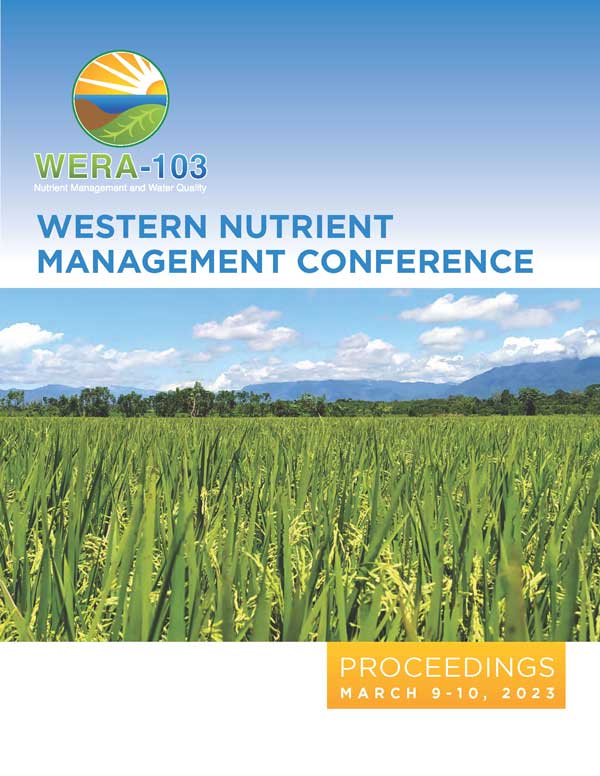Download the Conference Proceedings
Proceedings
Topics
| Filter results7 paper(s) found. |
|---|
1. 15Nitrogen Uptake and Use Efficiency in Corn in Response to Fertilizer Rate and TimingUrea fertilizer applications at planting are becoming increasingly common for U.S. upper Midwest corn (Zea mays L.) production but wet spring conditions may result in significant nitrogen (N) fertilizer loss. Split-applications may avoid wet conditions and improve fertilizer uptake and use efficiency. Six field studies were performed to determine the effect of urea fertilizer rate and application timing on fertilizer-derived N (FDN) and soil-derived N (SDN) plant uptake over two cons... F. Fernandez, J. Spackman |
2. Is Mitigation of Drought Stress By Zinc Oxide Nanoparticles Driven By a Nano-Specific Mechanism or Alleviation of Micronutrient Deficiency?It has been reported that zinc oxide (ZnO) nanoparticles (NPs) can promote drought tolerance in crops when used as soil amendments. However, many of these experiments were conducted in Zn-deficient growth media with no comparison to currently available Zn fertilization methods, making it unclear if the benefits from adding ZnO NPs were caused by a nano-specifc mechanism or simply by the mitigation of a micronutrient deficiency. A review of the literature shows that of 12 published experimen... J.W. Deakin, M. Potter, A. Cartwright, J. Hortin, D. Sparks, J.E. Mclean, D.W. Britt, A.J. Anderson, A.R. Jacobson, L. Yen |
3. Enhanced Efficiency Nitrogen Fertilizer: Coated UreaNitrogen is the most common fertilizer applied to crops, as it is typically the limiting nutrient in plants. However, about half of the nitrogen added to soil as fertilizer is either emitted to the atmosphere as ammonia, nitrous oxide or other gaseous forms, or finds its way into surface or ground waters as nitrate (Kibblewhite, 2007). The inefficient use of fertilizers depletes natural resources, and increases atmospheric emissions and environmental pollutants. With the use of enhanced effic... B. Geary, S.R. Fahning, B.G. Hopkins |
4. Enhanced Efficiency Phosphorus FertilizersPhosphorus (P) is essential for plants. However, first-year phosphorus fertilizer uptake by plants is low, resulting in economic and environmental impacts. Developments with P Enhanced Efficiency Fertilizer (EEF) sources show improved uptake efficiency and increased yield and/or crop quality, while reducing environmental risk. Research with EEFs (including organic acids, maleic itaconic copolymer, and struvite) all show these improvements, especially when: 1) soil test P concentrations are lo... B. Hopkins, S.J. Kobza, C. Seely |
5. Nitrogen and Water Management for Optimized Sugar Beet Yield and Sugar ContentSugar beet (SB) production is based on maximizing: root yield, and sucrose content, and sucrose recovery efficiency. Efficient nitrogen (N) and water management are key for successful SB production. Nitrogen deficits in the soil can reduce root and sugar yield. Overapplication of N can reduce sucrose content and increase nitrate impurities which lowers sucrose recovery. Application of N in excess of SB crop need leads to vigorous canopy growth, while compromising root development and sugar pr... O.S. Walsh, S. Shafian, D. Jayawardena |
6. Static Range Nitrogen Management in Northwest U.S. Sugarbeet ProductionNitrogen (N) management is important in sugarbeet production. This paper presents data to support a shift from a yield-based N management approach to a static range N management approach in the Northwest U.S. Production data and research show that yield-based N management can result in over application of N. Past research has been critical to improving and understanding sugarbeet N nutrition. However continued research is needed so cumulative data can be evaluated to improve management practi... D. Bjorneberg, D. Tarkalson, D. Olsen |
7. Improving Corn Nitrogen Management Recommendations in the Northwest U.S.The current nitrogen (N) fertilizer recommendations for corn in the Northwest U.S. were developed from limited research (14 potential site-years) in the 1970’s and 1980’s. New data is needed to improve N fertilizer recommendations. Between 2010 and 2017, 17 N rate studies were conducted. Fifteen site-years were conducted for corn grain and 9 site-years for corn silage. Research was conducted on diverse soil types, tillage systems, irrigation systems, ... D.D. Tarkalson, D.L. Bjorneberg |
